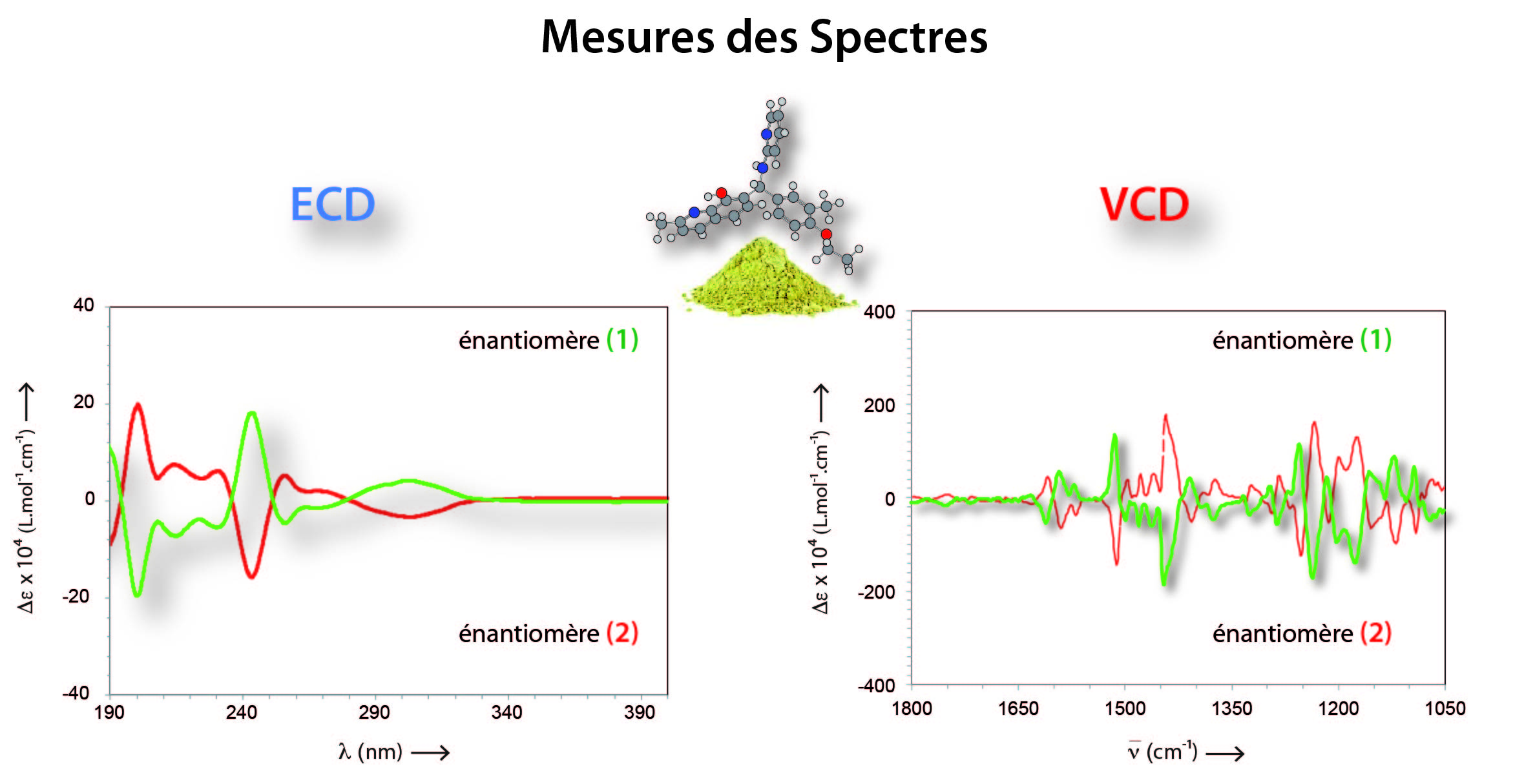Chiroptical Spectroscopy
Notre service est spécialisé dans la caractérisation des molécules chirales et plus particulièrement, dans la détermination de la configuration absolue par spectroscopies chiroptiques. Nous réalisons des analyses par dichroïsme circulaire vibrationnel (VCD), dichroïsme circulaire électronique (ECD) et dispersion du pouvoir rotatoire (ORD).
Nous proposons aussi des analyses spectrales qualitatives classiques (caractérisation de structures) dans les domaines du proche UV (190-390nm) et du visible (390-750nm), de l’infrarouge proche (4000-13400 cm-1), moyen (400-4000 cm-1) et lointain (30-400 cm-1).
The samples we analyze come from academic or industrial research laboratories working in various fields of chemistry: pharmaceuticals, materials, agri-food...
Our resources
PMA50 (Bruker)
Module VCD associé à un spectromètre VETEX70. Le module est équipé d’un détecteur HgCdTe D316 (InfraRed associates, inc.) d’une autonomie de 24h pour la réalisation d’expériences sur plusieurs jours. Les mesures peuvent être réalisées dans la gamme spectrale 800-3800 cm-1
.

VERTEX 70 (Bruker) :
Fourier transform spectrometer (FTIR) used for routine analysis or advanced experiments. The VERTEX70 offers a wide choice of parameters. It can be configured to work in the 3 infrared spectral ranges: near IR (12000-4000 cm-1), mid IR (4000-400 cm-1) and far IR (400-30 cm-1).

TENSOR 27 (Bruker) :
Fourier Transform Spectrometer (FTIR), used for routine analysis in the mid-infrared (400-4000 cm-1).

Preparation of samples for IR & VCD analysis
Samples analyzed may be liquids, gels or solids. We do not analyze gases. For measurements of solutions or gels, we have several removable cells equipped with windows covering a wide spectral range: NaCl (700-28000 cm-1), CaF2 (1200-66000 cm-1), BaF2 (900-50000 cm-1). Solids measurements can be carried out :
- A l’aide de pastilles obtenues par compression d’un mélange du produit à analyser avec du KBr ou du PET.
- A l’aide d’un mélange du produit à analyser avec du Nujol.
For routine infrared measurements on pure products, we offer a single reflection attenuated total reflection (ATR) accessory with Platinium diamond crystal (Bruker). This accessory can be fitted to the TENSOR 27 and VERTEX 70 spectrometers. It can be used in the 30-8000 cm-1 spectral range.
J815 (Jasco) :
Spectromètre dédié à la mesure des spectres ECD et ORD. Il est configuré pour travailler dans une gamme spectrale étendue : 180-1000 nm. L’appareil dispose d’un système Peltier pour un contrôle précis de la température. Les spectres ORD sont mesurés à l’aide de l’accessoire ORDE402 (Jasco).Le spectromètre J815 peut être équipé d'un aimant permanent de 1,6 Tesla pour des mesures de spectres MCD.

V670 (Jasco) :
Dual-beam spectrometer used for routine analysis or more complex experiments. This instrument can work in a wide spectral range from near UV to near IR: 190-2700 nm. It can be fitted with various accessories:
- Peltier system ETCS-761 (Jasco) : Operating temperature 0 to 100 °C
- 60 mm horizontal integrating sphere (Jasco) for analysis of powders, gels or liquids
Products can be analyzed in various forms: pure or diluted liquids, gels or solids.

Preparation of samples for UV-vis, ECD & ORD analysis
Samples can be liquids, gels or solids. We do not analyze gases. For measurements of solutions or gels, we have several quartz cells with different optical paths (0.1mm to 10 cm). For solid-state measurements, as with infrared, we can manufacture pellets or use the integrating sphere for reflection measurements on powders.
Détermination de configuration absolue par spectroscopies CD
Absolute configuration determination using VCD and ECD requires 3 steps:
1. Measure the CD spectra of the two enantiomers, where available. Circular dichroism is the ability of a molecule to absorb circularly polarized light differently to the left (PCG) and right (PCD). For optimum results, each sample analyzed should be chemically pure and have an enantiomeric excess (ee) as close to 100% as possible. When both enantiomers are not available, the measurement can be carried out with a single enantiomer. Samples are generally measured in solution. Although more delicate, it is also possible to analyze samples in the solid state. The quantities required for CD analysis of a product depend on its nature: they can vary from a few mg to several tens of mg. The solvents used are standard infrared spectroscopy solvents for VCD and UV-vis spectroscopy solvents for ECD.

2. Modeling of spectra using quantum chemical methods (DFT, TD-DFT) for a chosen absolute configuration. This step requires a proper description of the measured solution. Particularly in VCD, environmental effects such as the existence of solute-solvent interactions can have important consequences on the shape of the spectrum. Our department has many years' experience in this field and can provide assistance in carrying out this step. It should be noted that this stage generally determines the duration of the analysis: from a few days to several months.

3. Determination of absolute configuration by comparison of measured and calculated spectra.

Rotational dispersion spectra (ORD), also known as circular birefringence spectra, show the evolution of rotatory power over a spectral range. They enable more reliable characterization of enantiomers, and should be preferred to simple rotatory power measurements.
